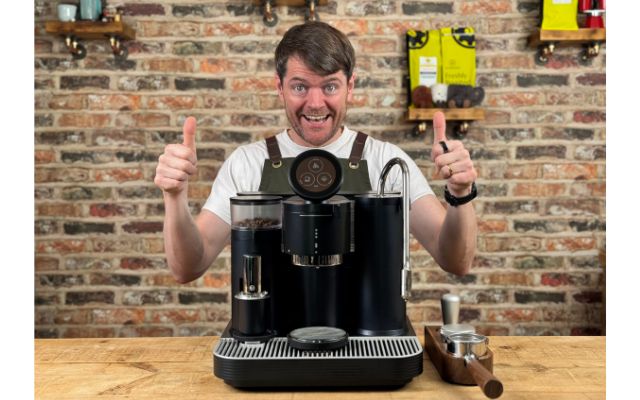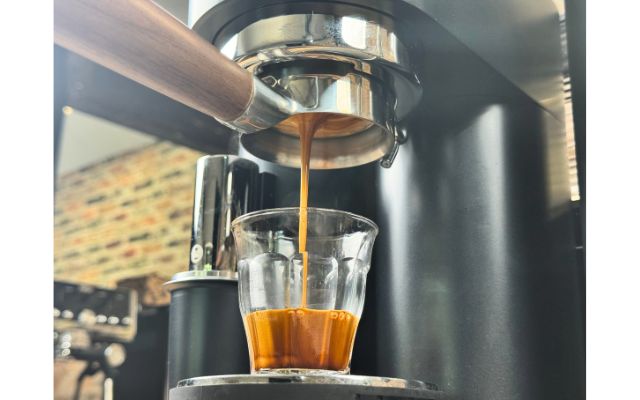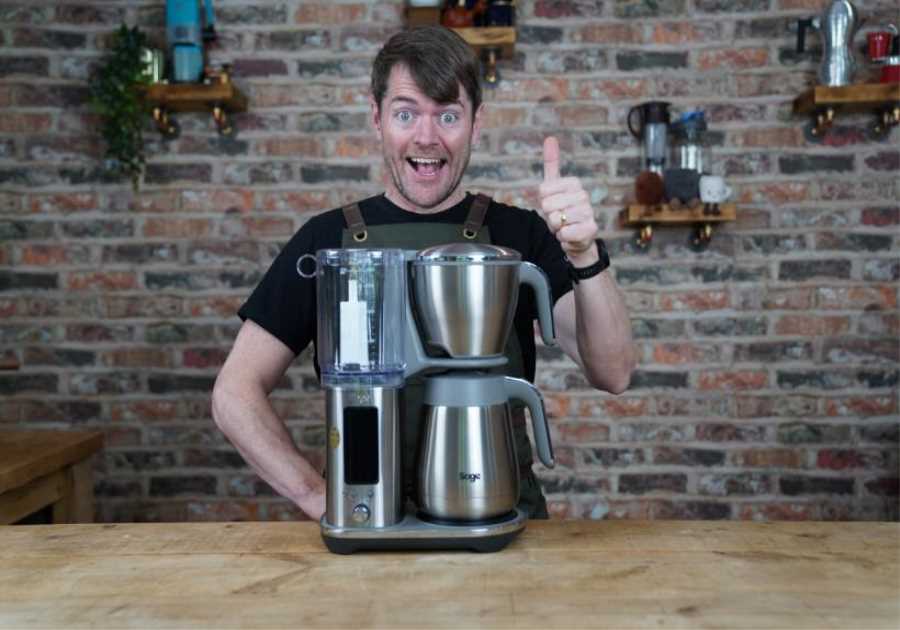If you’ve been looking for an all-in-one espresso machine with an integrated grinder, I’m guessing you’ve already heard about the Meraki Espresso Machine.
A dual-boiler espresso machine with unusual space-age looks, a built-in Timemore grinder, with grind by weight, stop by weight, and other surprising features for a very competitive price, the Meraki has grabbed a lot of attention.
But is this a ground-breaking machine that could literally change the future of home espresso, or is it all bells, whistles, and style over substance?
Let’s find out!
Meraki Espresso Machine: Nutshell Review
I don’t want to assume that everyone reading this post is already familiar with the Meraki coffee machine, so here's a quick introduction for those who aren’t.
Dual Boiler & Integrated Grinder
The Meraki is a dual-boiler espresso machine. It has a boiler for espresso and one for steam; you can steam milk and pull shots simultaneously.
It’s also an integrated grinder espresso machine, so you don’t need a separate grinder. This is rare for dual-boiler espresso machines. In fact, the only other integrated grinder dual boiler espresso machines are the Sage Oracle and Oracle Touch, both of which cost more than the Meraki machine.
Auto Dose Weight & Espresso Weight
This is what I think is most special about the Meraki espresso machine.
Yeah, it has loads of cool stuff that I do think translates into a great user experience, but if I was shopping for an integrated grinder portafilter machine and I found one with grind by weight and stop by weight, I would be trying to force that company to take my money!
Do you need an RFID scanner, 20 pre-heat schedules, a rotary pump and so on? Maybe not. You might want them, but you probably don't need them.
Do you need a grind by weight and stop by weight, given that you're clearly interested in an integrated grinder espresso machine? Yes, you do!
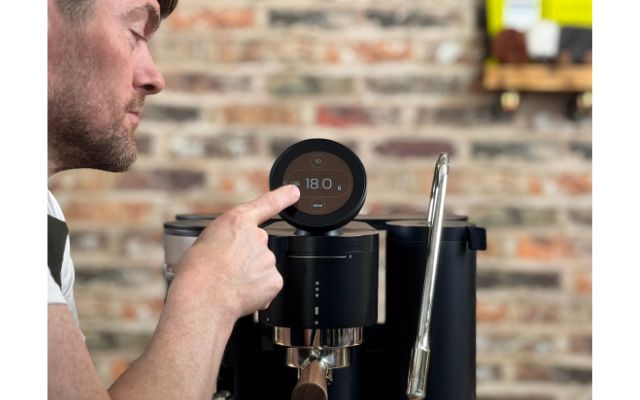
Grind by Weight
The Meraki espresso machine has built-in scales on the grinder side of things, so you just tell it what dose weight you want (meaning the weight of ground coffee in the basket).
Some premium espresso grinders have this feature, and it’s very convenient – but to see such a convenient feature on an integrated grinder espresso machine was a surprise! It’s not just convenient, though; combined with the stop-by-weight feature, it’s a lot more than that.
Stop by Weight
There’s also a built-in brew scale, with the scale plate sitting under the group head. And you can program your desired shot weight into the touch screen.
The issue with volumetric shot control (which most machines have) is that they control the amount of water entering the group. They don’t set the shot volume. This is determined depending on how much water is retained in the grounds, which can vary quite a bit.
So, being able to set the shot to stop by weight on your Meraki coffee machine gives you much more precise control over the brew ratio, which is a significant variable.
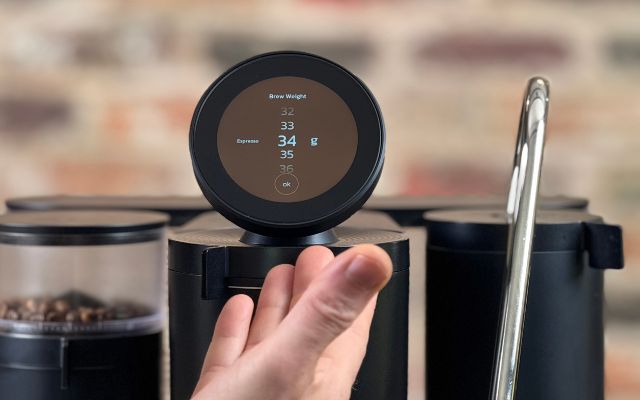
Automatic Espresso Ratio
As a result of these two features, you nail the brew ratio every single time, simply by going in once and setting your dose weight and shot weight. If you want a 1:2 ratio, for example, all you need to do is set your shot weight to be double the dose weight, and that’s that.
Integrated grinder machines often have lots of flashy-sounding features, but this is something that I would absolutely want from a machine like this.

Barista Quality Coffee, Automatic Bean-to-Cup Machine Like Convenience
The stuff I've just been going on about is responsible for the Meraki espresso machine being capable of stonking cup quality.
If you're looking for this kind of espresso machine, though, you're probably seeking the kind of convenience that you wouldn't usually get from a traditional espresso machine setup. And Meraki has clearly worked hard to deliver this.
Speedy Heatup Time
This is a fast-heating machine. If you're not familiar with dual-boiler espresso machines, you might not think that 2 minutes 35 seconds for brew ready and 2 minutes 55 seconds for steam ready is quick, but it is very fast for a dual-boiler.
Fast, Easy Yet Brilliant Milk Frothing
There’s a serious-looking pro steam wand with a temperature probe in the tip, so you can steam automatically. It may look slightly intimidating, but it's the easiest manual steam wand I've ever used, and it'll do it hands-free, too, if you prefer. There's a temp probe in the steam tip, so you can simply punch in your preferred milk temperature.
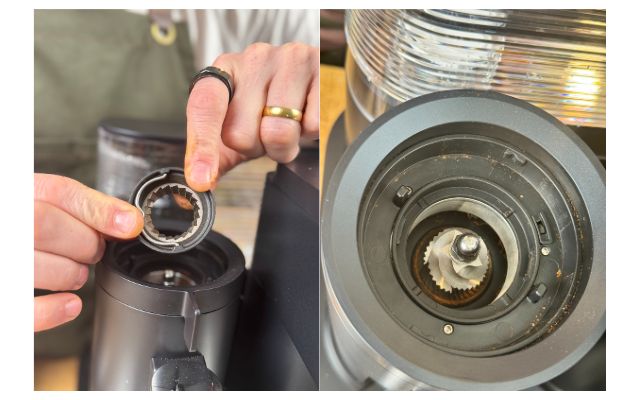
37mm Conical Steel Burrs
The bean hopper and the burrs are removable, so you can easily get to the burrs if you have an issue or to keep them clean. I think officially they're actually 38mm, but Tom from Tom's Coffee Corner measured them, and they're just a tad over 37mm.
Touch screen interface
The unusual-looking circular touch screen is very easy to use, and it's full of very useful features. It's not the same kind of deal as machines like the Sage Barista Touch Impress or Oracle Jet. Meraki has focused more on function with the touch screen, and I think their ideal customer will absolutely love this.
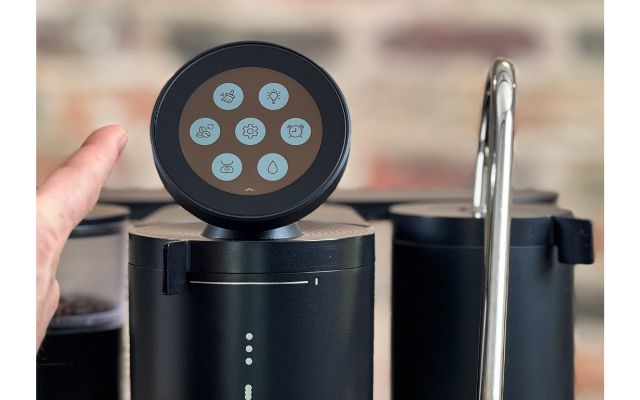
WiFi Updates
It has a WiFi chip, and automatically updates the operating system and the firmware for the microcontroller unit. What this means is that you don't need to worry too much about the risk of being an early adopter. Most updates to the Meraki coffee machine are likely to be firmware updates, so you'll benefit from them when they're rolled out.
PID Temperature Control
This means the Meraki espresso machine has an algorithmic temperature controller, which controls the temperature by having the ability to act on feedback it receives from the temperature probes. It's adjustable, which means you have a wide range of temperature settings, both for brew temperature and also multiple temperature settings for the group head heater.
Rotary Pump
Having a rotary pump is rare for a machine at the price of the Meraki, and it means less noise and vibrations than with a vibration pump machine, and potentially better pressure stability.
Having a rotary pump would usually also mean you can plumb the machine in, but Meraki has chosen not to offer a plumbing kit, which I think is a mistake. They have what sounds like a good reason for this decision, but I still think it’s a mistake, for reasons I’ll share a bit later in this review.
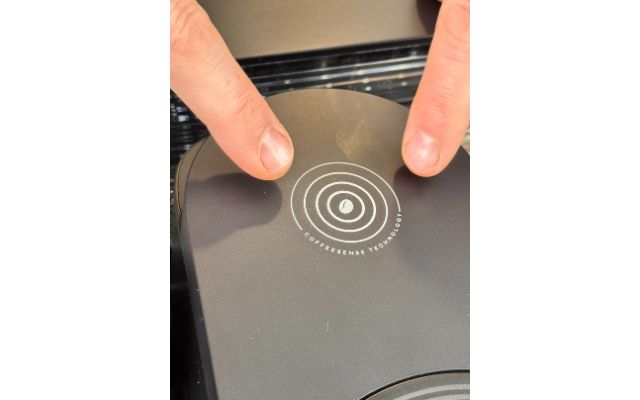
Meraki Coffeesense Technology
There's a scanner on the top of the Meraki espresso machine on which you can scan RFID tags.
This means that coffee roasters can produce a tag for their coffee for Meraki coffee machine owners to scan in, which automatically sets the recipe (brew temp, dose weight, shot weight, suggested grind size) for that coffee.
This is potentially a huge deal in the future. It would mean that – for example, if you bought a bag of Chocolate Brownie Blend from The Coffeeworks (my coffee, not a shameless plug in any way, hehe), instead of having to go to our espresso recipe guides page, find the recipe, and manually set it up, you'd simply scan the tag and crack on.
Meraki Espresso Machine Review – In Depth
Features
- 58mm heated group head (adjustable temperature settings)
- Dual stainless steel boilers (300ml brew / 550ml steam)
- Rotary pump (9 bar)
- 58mm heated group head (adjustable temperature settings)
- Adjustable PID (85C – 96C / in 1C increments)
- Stepless Timemore grinder (grind-by-weight)
- Integrated brew scales (stop-by-weight)
- Removeable bean hopper (and removeable burrs)
- Ball-jointed pro steam wand with 3-hole tip (temperature sensor in tip)
- Manual and automatic milk steaming
- Simple to use touch-screen
- Auto on & heatup scheduling (20 schedules)
- RFID scanner (for scanning in espresso recipes)
- 2L water tank (with low-level warning)
- 0.6L drip tray (with grinds-catcher & “empty me” indicator)

Meraki Espresso Machine: Gamechanger Or Style Over Substance?
When I first noticed the Meraki espresso machine Kickstarter campaign, I didn't pay a great deal of attention.
It looked space-age, it seemed way too good to be true, and I assumed that even if it did get funded and make it to production (one doesn't always lead to the other), it would be style over substance.
It did get funded, to the tune of about 1.5 million pounds, so that was a success – and they did get it to production, too – the machine I've got is one of the first production models.
Prototype Issues – Did Meraki Resolve Them?
The Meraki guys might have made a rod for their own backs by choosing to treat reviewers as beta testers. Instead of sending them to separate beta testers and then to reviewers, they merged the two. It does show a level of honesty and integrity. Still, the issue with doing this is that all of the teething problems have been shared in review videos, and it might not be completely obvious to everyone that these reviews are tests of prototypes.
Most of the video reviews of the Meraki espresso machine initially showed concerns in various areas, including temperature stability, steam power, heat-up time, and more.
I received one of the first production models, and I'm happy to report that Meraki has addressed just about all of these issues.
They added more group head heater temperature options, increasing the max from 50°C to 70°C. They managed to improve the heat-up time to just 2 minutes 35 for brew and 2 minutes 55 for steam (from my testing, UK, 240V).
They resolved little wobbles and rattles, bugs in the firmware, and confusion relating to the heat-up schedules. Meraki also improved the portafilter (the handle is now more robust), but I still think the portafilter ears are slightly too big, and it's overly stiff when locking and unlocking. Well, they tell me that there's a new, improved portafilter since the one I received, and they're sending it to me.
The grind-by-weight accuracy has improved since the prototypes. In my testing with the Acia Lunar, the majority of the time it’s been either exactly the same, or 0.1 – 0.2g out, which is pretty flipping good.
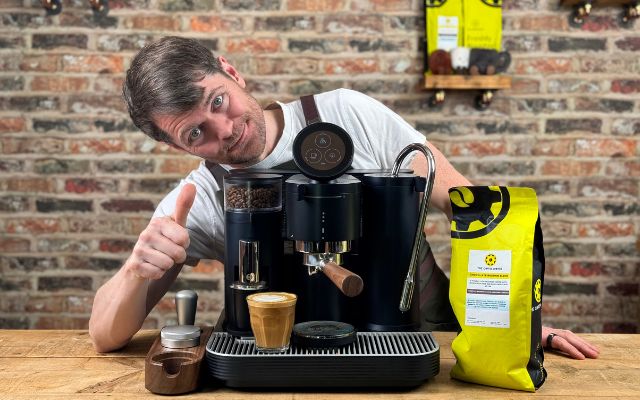
Is the Meraki Espresso Machine Ready to Buy?
While I think Meraki could make a few improvements, they're mainly firmware-related, so they wouldn’t put me off ordering at this stage.
The Meraki coffee machine has two separate pieces of firmware that are updated over Wi-Fi: the MCU (Microcontroller Unit), which controls the hardware, and the “Espresso OS,” which is the operating system.
Both have had several updates, with the OS seemingly having had a large number of updates since the initial testing.
In case you’re interested, (at the time of writing, not long after they started releasing the production models) the machine I have is on Espresso OS 1.1.1-57, and MCU: V4.0.6.
The only thing they don’t seem to have perfected yet with the OS is the situation where the Meraki espresso machine actually turns itself off instead of going to sleep. This isn’t a big deal, but it needs sorting. I also think Meraki could give the user more control over the sleep time, and the ability to schedule just one of the boilers to heat up at certain times of the day would also be a great addition.
The one issue I have right now about ordering a Meraki espresso machine is the portafilter situation. If you order one, hopefully you’ll receive the new portafilter. If you don’t, I’d highly recommend getting onto Meraki and insisting that they send you a new one, because a portafilter that doesn’t properly fit obviously isn’t fit for purpose.

Is the Meraki Espresso Machine a Game-Changer?
On paper at least, an integrated grinder with grind by weight, stop by weight, an RFID scanner, and various other practical features, should be a game changer, so is it?
Yup!
Even without the RFID scanner, which I do think will end up being a big thing, especially when roasters get behind it (at which point other brands would be crazy not to get in on the action), I think the Meraki espresso machine is a game-changer.
In fact, since I've been testing it for the past couple of weeks I've come to the conclusion that if I was on the market for a dual-boiler espresso machine right now, I'd buy the Meraki if I was mainly focusing on finding the perfect balance between convenience and cup quality at this kind of price point.
Given all the machines I've reviewed to date, this is really saying something.
Meraki Espresso Machine Vs Sage Oracle Touch, Oracle Jet & Ninja Luxe
The most popular, best-selling integrated grinder espresso machines, at the moment, are the Ninja Luxe Cafe, Sage Oracle Jet & Oracle Touch. To give a very quick idea of just how many unique features the Meraki espresso machine has, check this out:
| Meraki | Oracle Touch | Oracle Jet | Ninja Luxe | |
| Integrated Grinder |  |
 |
 |
 |
| Grind By Weight |  |
 |
 |
 |
| Stop By Weight |  |
 |
 |
 |
| Rotary Pump |  |
 |
 |
 |
| RFID Scanner |  |
 |
 |
 |
| Auto-on Schedules |  |
 |
 |
 |
| Barista Assistance |  /  |
 |
 |
 |
| Dual Boiler |  |
 |
 |
 |
| Wifi Updates |  |
 |
 |
 |
| Heated Group |  |
 |
 |
 |
| Stepless Grind Adjustment |  |
 |
 |
 |
The reason I've put both yes and no in the Barista Assistance box for the Meraki, by the way, is that although it doesn't have what Sage & Ninja refer to as barista assistance, Meraki has its own form of barista assistance in the form of the RFID scanner.
I realize that the Ninja Luxe is fighting in a much heavier weight class in this table, but that just goes to show what a success the Luxe is! It might not have all the features of the others, but that's because this is really an espresso-centric review, given that it's a review of a pure espresso machine.
I'll go into this in more detail in the appropriate section, but don't take the above table to mean that the Meraki is the best espresso machine for you just because it has all the ticks – it all depends on what you're looking for. If you're looking for the biggest drinks menu, the Ninja Luxe column would have more ticks than a Nike shop; it's like having Starbucks in your kitchen!
How Low Is the Grind Retention of the Meraki Espresso Machine?
I’m talking here about exchanged retention, which means some of the grounds that were retained the last time you ground coffee enter your basket the next time you grind.
The bigger the exchanged retention, the more coffee entering your basket is stale and/or at a different grind size. The benefit of grinders with very low retention is that you don't need to purge coffee (grind some and throw it away).
From what I can see, the only thing they're using to reduce the retention is the “Ion beam”, which might sound super high-tech, but it’s just an ionizer. They reduce static slightly, which can help to reduce retention. The result is that the exchanged retention, from my testing, has been about a gram at most.
Is this enough to never have to purge? Personally, I’d say maybe not. It’s completely up to you, but I usually purge just a gram or two each time I come to use it, unless I’ve just made a shot with it and I’ve not changed the grind size.
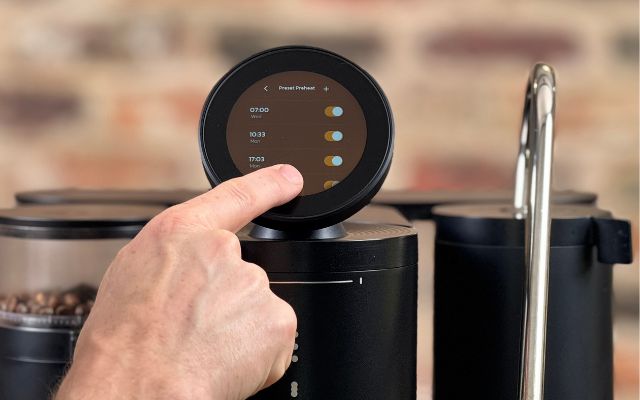
What Are the Heat Up Schedules?
The Meraki espresso machine has 20 heat-up schedules, and what this means is that you can program it to turn on and heat up, from being asleep or turned off at the button.
20 may seem over the top, but maybe not when you consider that you can program it for different days of the week. So, maybe, you’d set four schedules for all weekdays (this would take up four of the twenty available), and then four different times for Saturdays, and four different times for Sundays.
OK, this would still only take up 12 of the 20 schedules, but that’s great. Whoever said “less is more” was talking rubbish ;-).
What Is the Meraki Espresso Machine Like to Use?
Touch-screen Interface
The Meraki espresso machine's touch screen is mega. I love it. It's just very intuitive; there are usually three icons on the screen – grinder, steam, and brew. So you just tap one of these depending on where you are in the process.
If you want to do anything other than make espresso or steam milk, you just swipe down from the top to reveal the bigger menu, and it's completely obvious what all the icons mean. Anything that isn't on this screen is accessed by the central cog icon for the detailed settings.
The interface does tilt slightly, so for anyone who happens to be slightly vertically challenged, this will help, although I think it would be helpful if it tilted more, especially for anyone who uses a wheelchair.
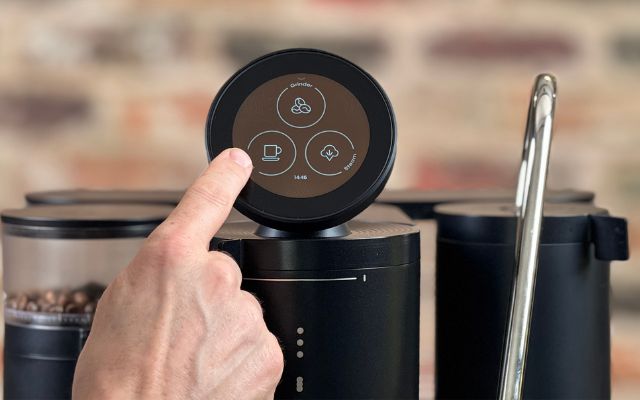
Espresso Workflow
Grind-by-weight and stop-by-weight lead to an incredibly convenient, faff-free, and satisfying espresso workflow.
Presuming that you’ve already selected your dose weight and shot weight (it remembers these until you change them again), all you have to do is:
- Load your beans into the hopper, tap the grind icon, and tap grind to start.
- Remove the dosing cup from the scale & dose the portafilter.
- Drop the dosing cup back onto the scale, towards the front so it slides into position by itself, as if by magic.
- Spin the spinny thing (distribution tool), an optional step, but it's fun.
- Tamp (pressure isn't important, just try to be level and consistent)
- Lock in the portafilter (which, in my case, isn’t as satisfying as it should be, but hopefully you’ll get the improved portafilter).
- Tap “brew”, and then tap the play button
Your shot will stop at more or less exactly the desired shot weight and therefore your target brew ratio. Enjoy!
If you prefer, you can use the brew paddle to start and stop the shot manually – you'll still see the shot time and weight on the screen.
Workflow for Latte & Cappuccino
This is by far the best workflow I’ve experienced for milk steaming with an integrated grinder machine. The Meraki espresso machine's steam wand is so easy to use—it’s crazy. I’ve never used a steam wand that is as easy to use, even on full power, which results in a steaming time of about 20 seconds for 170ml of milk, about enough for a single flat white.
I don't just mean this for integrated grinder machines, either. This is the easiest steam wand I've ever used, full stop.
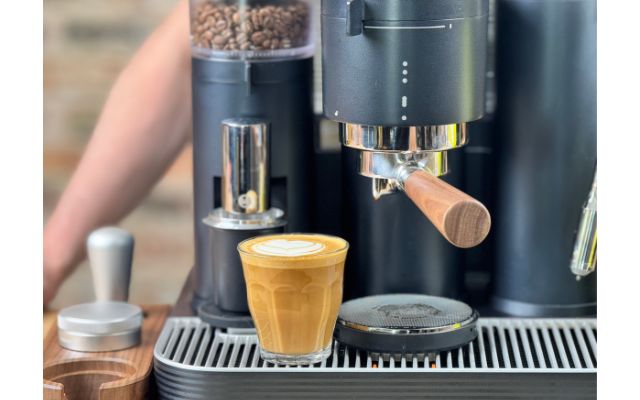
Manual or Auto Milk Steaming – Hands On
You can start the steam on the Mearki espresso machine manually via the steam paddle, or you can tap the steam icon on the screen.
If you do it via the screen, it automatically stops at your pre-set temp. If you do it via the paddle, you have to stop it manually.
I think they should give an option to have it stop at the pre-set temperature, even if you start it manually. Starting the steam manually is quicker, but it's a bit more of a faff to stop manually, because you lose the shot temperature off the screen for a few seconds.
It’s not for long, but if you feel like you're close to full temp but can't see what it is, it's irritating.
I do think they’ll fix this. When I first got it, the milk temp didn’t come back at all after the shot stopped unless you pressed the OK button on the screen. However, they updated that. It’s better as it is, but I still don’t think it’s quite right. I think they should just leave the milk temperature on the screen the entire time.
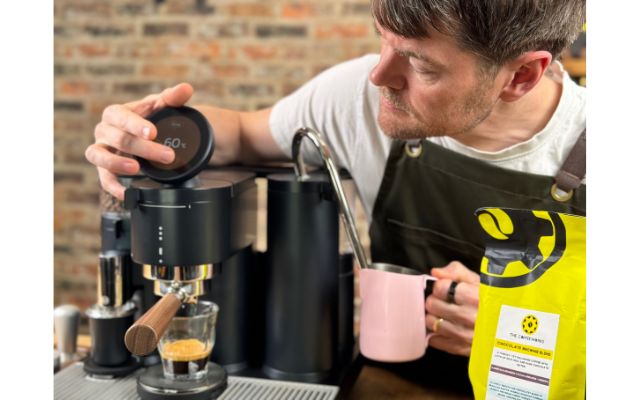
Auto Milk Steaming – Hands Off
If you want to steam fully hands-free, this is simply done by putting the jug down on the drip tray, setting the wand in position, and then pressing the steam icon so it stops at the desired temperature.
It doesn’t have an air pump to do this, by the way, like the Sage machines. It’s literally just “ghost steaming”, which you can do on most machines, but it works very well with the Meraki espresso machine because you can program the milk temp, and just because the wand is so easy to use.
Depending on the size of your milk jug and how much milk you're steaming, you may need to raise the jug up with something to reach the surface of the milk with the steam wand tip. I've found the lid from a tin of hot chocolate flakes works perfectly for this, randomly!
Meraki Espresso Machine: Milk Steaming Tutorial
The following is the same whether you're doing it hands-on or hands-free; if the latter, all you'll need to do is move the wand slightly if the position you start at sounds like the steam tip is too deep, or not deep enough.
- Give the wand a quick purge to get rid of any condensation sitting in the wand tip.
- Pour your milk into your cup and then into your jug, so you know roughly how much milk you need.
- Insert the tip into the milk, open up the steam, and aim for a subtle intermittent hissing sound. If there's no hissing, drop the jug slightly to bring the tip closer to the surface.
- If you started the steaming manually with the steam paddle, stop it at your desired temp (mine is usually around 60°C if I want to down it, maybe 63-65 if I want to savour it).
All you need to do from here is experiment with how aggressively to stretch and how long to stretch for.
If you want micro-foam, for modern “silky” flat white texture, you wouldn't usually want to create a gap between the milk and the steam tip that results in any more than a gentle, intermittent hissing sound.
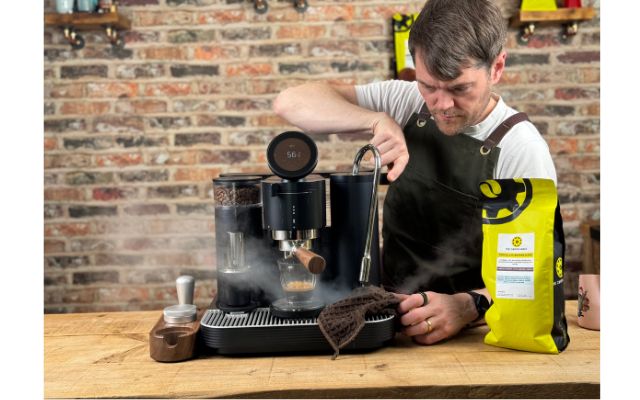
If you want big, chunky, 90s cappuccino foam you can stand a flake in, though, then you might want to go more aggressive, aiming for more of a roaring sound than a hissing. Think angry dragon vs fairly chilled-out python.
You probably wouldn't want to keep that up for long, though, before lifting the jug to stop aeration, or you may stretch the milk right out of the jug & all over your kitchen. Personally, I've left big bubbled micro foam in the 90s, so I always seek the chilled-out python, which would seem weird out of context.
How long you keep up the stretching will depend on the drink you're making and the milk you're using. Just experiment and see what works for you. If you have too much foam, stretch for a shorter time in the future.
Apologies to those with hearing impairments; these instructions are very audio-centric. If you can't hear the sound of the aeration, you'd need to focus on how it looks. If it's stretching fast with big bubbles forming, raise the jug to reduce the gap.
Meraki Esspresso Machine: Cold Froth Hack Tutorial
Officially, you can't create cold froth with the Meraki espresso machine. Unofficially, you can make a version of cold milk froth, with any steam wand in theory, but it works very well with the Meraki, as it's just so easy to blast in air quickly.
- Pull your shot of espresso over ice, assuming you want to make an iced coffee.
- Put milk and ice in your milk jug.
- Insert the wand tip with a big gap for more aggressive aeration (angry dragon).
- Stop after 5 seconds or so.
What you should have is some form of cold froth – not the same level as on the Ninja Luxe, but better than nothing.
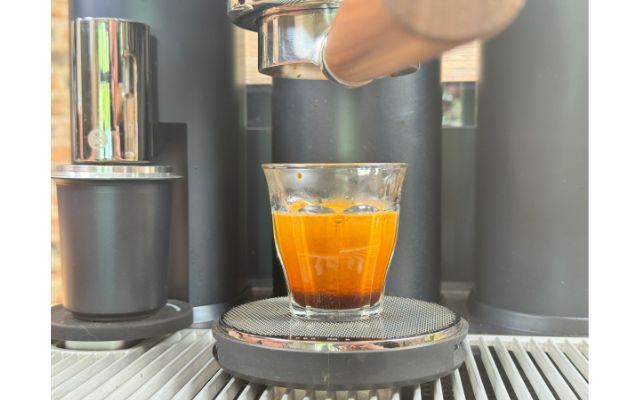
Will the Meraki Espresso Machine Work With Light Roasts?
I did say in my videos that I'd not challenged the machine with lighter roasts yet, because I didn't want to break it, at least not before I'd done the first two reviews.
Surely, being an integrated grinder machine, this machine won't work with light roasts, right? Wrong!
I'm very surprised to be able to report that the Meraki espresso machine DOES work well with lighter roasts. I'm not just talking about taste, either, which is subjective. I'm talking about the actual extraction percentage.
I've pulled shots with light, high-grown single-origin coffee beans with a TDS of 10.5% and an extraction % of 22%. If you're a light roast espresso nerd, you'll be, most likely, very impressed.
I will say that I think there's more chance of having issues over time with the grinder, using mainly lighter roasts. Some light roasts are very dense and will put quite a bit of strain on the grinder. So, I wouldn't be too surprised to hear of issues with stripped gears or other issues from using light roasts.
But in terms of performance, with the beans I've tested, I've made some really nice, well-extracted espresso with the Meraki, using light roast single origins. If you're surprised, I doubt you're as surprised as I was! ;-).
Who Is the Meraki Espresso Machine for?
If you're looking for an integrated grinder espresso machine and have the budget to consider the more premium options, the Meraki coffee machine is for you.
The reason I say this is that the only real benefit of integrated grinder espresso machines is the additional convenience that they deliver.
They don't really save space, they don't really save money, but they tend to have features that make them more convenient, especially if there will be others using the machine who haven't jumped down the home barista rabbit hole.
If you want mega espresso and espresso-based milk drinks, but you want some of the convenience that machines like the Sage Oracle Touch and Oracle Jet provide, then you're definitely who the Meraki espresso machine is made for.
If you're not the slightest bit interested in this, then you'd probably be better off looking at a stand-alone espresso machine and grinder, as there's a lot more choice, and having a separate grinder does make more sense, logistically.

Having said that, I'd imagine some of the features of the Meraki espresso machine, in particular the grind by weight and stop by weight, are converting home baristas who would never have considered going for an integrated grinder machine.
Would I go for Meraki vs something like the Lelit Bianca V3 paired with the Eureka Mignon Libra, personally, I don't think I would, simply because I know I'll have the same kind of workflow, but in a much more showpiece setup that I know will still be going strong in 10 years.
Would I buy this vs the Sage Oracle Touch, Oracle Jet, or any other integrated grinder machine on the market? Based on performance, absolutely. The only thing that would make me think twice is the risk of the unknown.
Some of the components are proprietary; you can't just go and get them off the shelf, and Meraki is a new outfit. So you are taking a bit of a punt on them still being around in 5 years' time if you do have an issue further down the line.
Alternatives to the Meraki Espresso Machine
There really isn't a straight alternative, as there's no other dual-boiler integrated grinder espresso machine with a rotary pump, grind by weight, stop by weight, or RFID scanner.
If I was going to include stand-alone espresso machines and grinder setups in this review, we'd be here all day ;-), as there are so many options. But as I've mentioned, what I think is really special about the Meraki espresso machine is the fact that it does what it does, and it's an integrated grinder machine.
If you're not fussed about the grinder being integrated, there's way more choice. See: Best home espresso machines.
Sage Barista Touch Impress
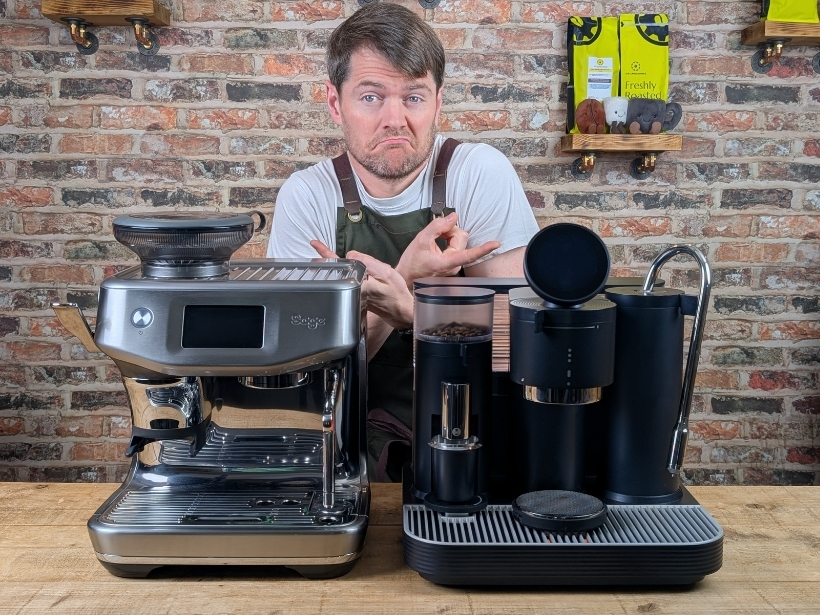
Check Price - SageCheck Price - Amazon
The Sage Barista Touch Impress is a few hundred quid less, and it's similar in that it's an integrated grinder espresso machine with a touch screen, and with a number of clever features.
It's not grind-by-weight, but to be fair, it does work as if it were, to a certain degree, thanks to the dose sensor.
This stops the grind when it thinks the dose is correct, you tamp using the tamp lever, and it prompts you to tap the screen to grind a bit more if it's slightly under-dosed, or to trim some off using the razor tool if it's over-dosed.
The touch-screen interface is very pretty and works well. It will steam manually or automatically and will do a good job.
Like all integrated grinder espresso machines I've ever encountered until the Meraki coffee machine, though, the Touch Impress is best-suited to medium-dark roasts.
This isn't a dual boiler, either. It's a thermocoil machine with an on-demand water heater. You can't steam milk and pull shots simultaneously, but you can queue up one to start when the other is done.
Sage Oracle Jet
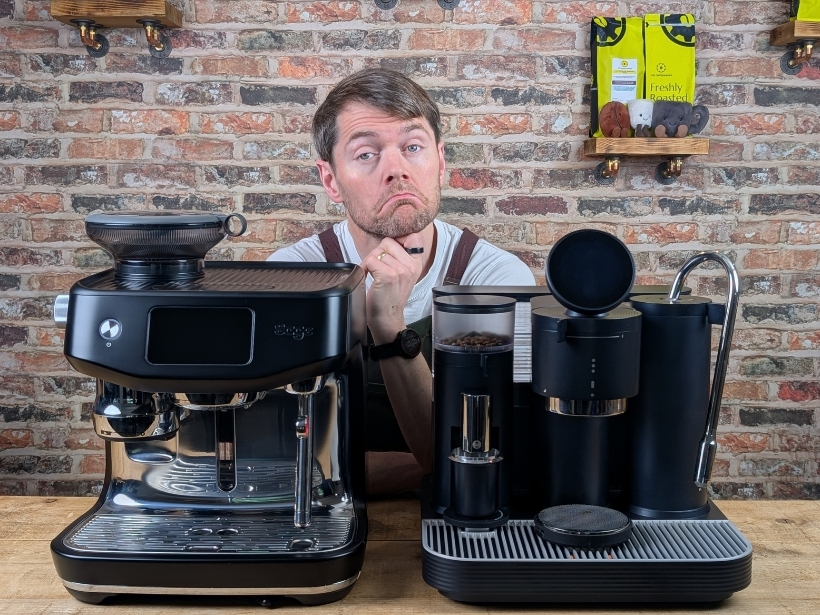
Check Price - SageCheck Price - Amazon
This is the integrated grinder machine at the time of writing that I think comes closest to the Meraki espresso machine. It's not a dual boiler. In fact, it doesn't have a boiler. The Sage Oracle Jet and the Touch Impress are thermocoil machines, and you can't steam and brew at the same time.
As with the Touch Impress, though, you can queue the milk to start steaming when the shot is finished, or vice versa.
The touch screen itself is very slick and responsive, powered by a quad-core processor. It's a very clever machine, but they still don't quite appear to have finished developing it.
It has a WiFi chip, which is great. It means they can push out WiFi updates, but there are still some issues with the Barista Assistance and the auto milk steaming that they've not fully resolved yet, and I wouldn't be very happy if I'd bought one of these 6 months ago.
I still think the Oracle Jet is mega, don't get me wrong, but it's slightly more expensive than the Meraki espresso machine. So, based on performance alone, I'd buy the Meraki.
The big plus for the Oracle Jet Vs Meraki is that it's a Sage coffee machine. Sage has been around for quite some time, so there isn't the same element of risk as with paying a premium price for a machine from a completely new brand.
Ninja Luxe Cafe
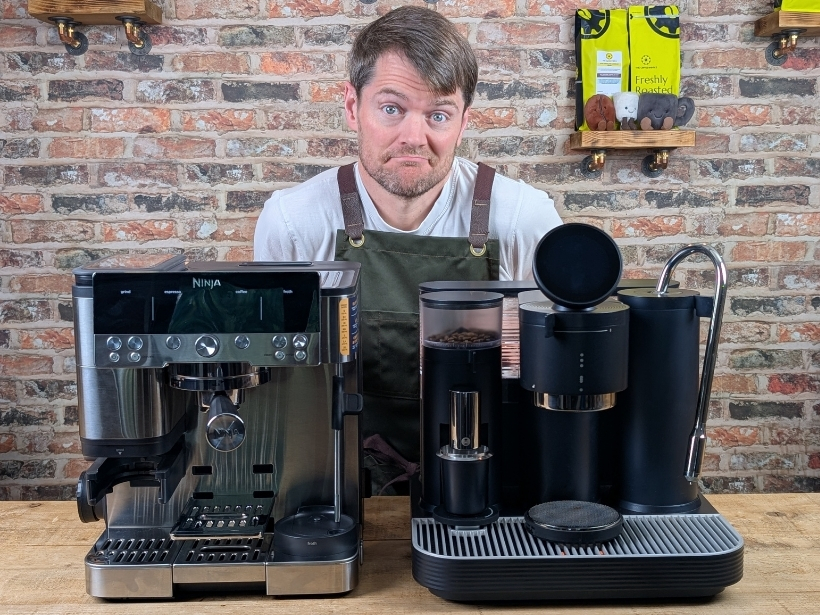
The Ninja Luxe is an integrated grinder machine with barista guidance. Some say it also has brew by weight, so it may seem to be similar to the Meraki espresso machine.
It doesn't actually grind by weight as such; this is a bit of a misunderstanding. It has scales, it records the weight internally and then uses this to learn from, over a few shots. This is very clever, it works well, but it achieves fairly broad results with medium-dark to dark roast espresso blends.
If you're looking for precision, especially if you're thinking about medium roasts or lighter, the Ninja machines probably aren't for you.
If “precision” makes you roll your eyes, though, you're not all that fussy, “OK” is more than good enough for you and you also want a big Starbucks-type drinks menu, then there's not a great deal on the market at the moment that matches the Ninja Luxe machines, in my opinion.
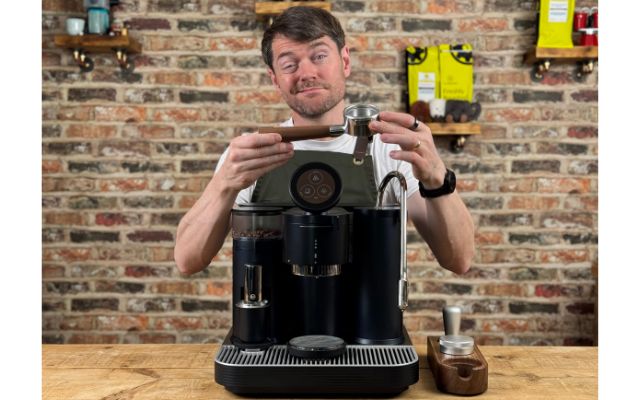
| Feature | Meraki Espresso Machine | Ninja Luxe Premier | Sage Oracle Jet | Sage Barista Touch Impress |
|---|---|---|---|---|
| Boiler Type | Dual Boiler | Thermoblock | Thermocoil | Thermocoil |
| Grinder Type | Integrated (Timemore, Grind by Weight) | Integrated (Smart Learning) | Integrated (Dose Control) | Integrated (Dose Sensor) |
| Shot Control | Stop by Weight | Volumetric | Volumetric | Volumetric |
| Barista Assistance | RFID-Based Recipes | Barista Guidance | Barista Guidance & Auto Dosing | Barista Guidance & Assisted Dosing |
| Milk Frothing | Manual & Auto w/ Temp Probe | Fully Auto Frothing | Fully Auto Frothing | Manual & Auto |
| Touchscreen | Yes (Functional First) | No (buttons) | Yes (fast & slick, quad core processor) | Yes |
| Rotary Pump | Yes | No (Vibration) | No (Vibration) | No (Vibration) |
| WiFi Updates | Yes (Firmware + OS) | No | Yes | No |
| Light Roast Compatible | Yes (Surprisingly!) | No | Not Ideal | Not Ideal |
| Auto On/Heat Schedules | Yes (20+ slots) | No | Yes (1 slot) | Yes (1 slot) |
| Price (approx.) | £1,423 (with discount code) | £549 | £1699.95 | £1199.95 |
| Best For | Espresso Lovers Seeking Precision & Convenience | Casual Coffee Drinkers & Families | Casual Coffee Drinkers & Home Baristas Seeking Convenience | Entry-Level Enthusiasts Looking to Improve |
Meraki Espresso Machine Problems
I usually finish espresso machine reviews with my likes and dislikes. This entire review is filled with likes, as I flipping love the Meraki espresso machine, as you can probably tell.
Portafilter Fit
I only really have one dislike, which is the portafilter fit. The ears are clearly too big, and it's way stiffer than it should be when locking and unlocking the portafilter. As I've mentioned, this has been fixed by Meraki. There's a new portafilter, but I've not seen this yet.
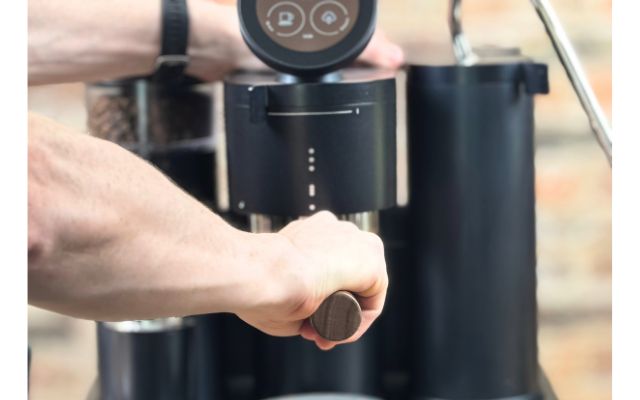
My other comments are more suggestions for future updates, rather than dislikes.
No Plumbing Kit
The Meraki espresso machine has a rotary pump. One of the benefits of this should be the ability to plumb it in. Meraki tell me they don't want to do this, as they're working hard to encourage customers not to use tap water. They also believe that customers would be put off going to the expense of fitting a water filter system rather than plumbing directly into the mains.
I think, personally, they'll lose sales due to not having a plumbing kit. Offering one doesn't mean customers are forced to buy it; it just gives the option.
Individual Boiler On/Off
The auto heat-up schedules are great, but I think they'd be even better if the machine heats up both boilers by default and offers the choice to select just one boiler. Maybe on Saturday mornings, at 7am, I only drink espresso, so what's the point of wasting energy to heat up both boilers?
Optional Splitter Gasket
The 2-in-1 portafilter, bottomless with the optional splitter, is great, but the gasket that connects them could do with being a tighter fit. It's fairly loose, and sometimes drops off.
Sleep Controls
At present, the machine goes to sleep after roughly 10 minutes. As I've mentioned, it sometimes actually shuts off altogether, but I believe they're working on fixing this issue.
I do think it would be great if the user had more ability to program the sleep time, possibly via the heat-up schedules.
For example, let's say I have a routine that involves having an espresso at 8am and a flat white at 9am. In this case, it might make sense not to allow the machine to go to sleep and for the boilers to cool down, as the energy to keep the boilers at temperature until the next schedule is probably going to be less than letting them cool down and then re-heating.
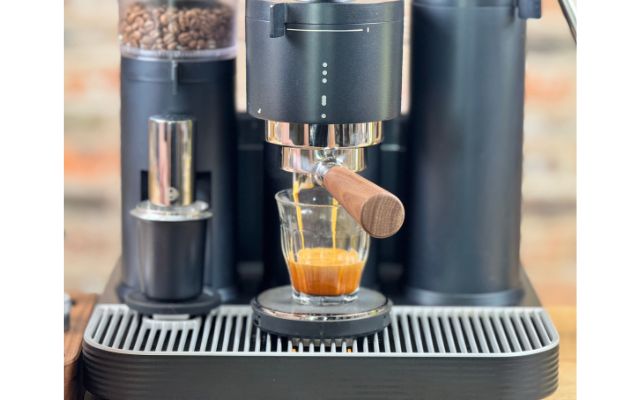
Conclusion – Is the Meraki Espresso Machine Your Perfect Espresso Machine?
To conclude, the Meraki espresso machine definitely isn't style over substance, as many people (myself included) assume when they first read about it. With real, practical features that are either unheard of among integrated grinder espresso machines or unheard of altogether, in my opinion, the Meraki coffee machine is a game-changer.
I'm not just talking about the space-age looks, the unusual-looking touch screen, and the RFID scanner. The workflow experience this machine delivers for espresso and milk drinks is next level, as is its compatibility with such a wide range of roast levels.
Does this all mean that the Meraki is the machine for you? Not necessarily; the great thing about espresso machines these days is there's plenty of choice.
But if it's within your budget, you're not a purist to the point that you wouldn't entertain anything but an all-metal machine, and you're willing to take some risk given that Meraki is such a new espresso machine brand, I think most people, who want an integrated grinder machine, will probably find it difficult not to buy the Meraki!
Kev's Meraki Espresso Machine FAQs

How Much Does the Meraki Espresso Machine Cost?
It's around £1500 in the UK, although if you use the discount code CoffeeKev100, you'll save about £76 ($100).
Is the Meraki Machine an All-in-One Espresso Machine?
It is, which simply means the coffee grinder is built into the machine, instead of having to have a separate grinder. Still, it's a lot more than that, due to the grinder scales and the brew scales, and the way everything works together with the firmware.
What's the RFID Scanner for?
The idea is that you'll be able to buy your coffee beans from roasters who work with Meraki, and the recipes for their beans will be encoded into an RFID tag. So, customers can just scan this in, and the machine will be automatically programmed for those beans to get you close to being dialled in without doing any faffing.
Does the Meraki Machine Work With Light & Medium Roast Coffee Beans?
Much to my surprise, yes, it does! I didn't expect any integrated grinder machine to achieve good extraction with light roasts, but my testing with the Meraki espresso machine proved otherwise, and I've had really good results with light roasts.
Light roast beans can be dense, though, so I have some concerns about the potential for grinder damage (gear-stripping, mainly) from using light roasts with a machine like this.
The post Meraki Espresso Machine Review, 2025: Is This the Future of Espresso? appeared first on Coffee Blog.
By: KevTitle: Meraki Espresso Machine Review, 2025: Is This the Future of Espresso?
Sourced From: coffeeblog.co.uk/meraki-espresso-machine-review/
Published Date: Sat, 24 May 2025 08:10:48 +0000
Always check our latest articles at...
https://coffeecutie.com/espresso-machines

